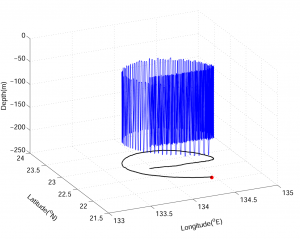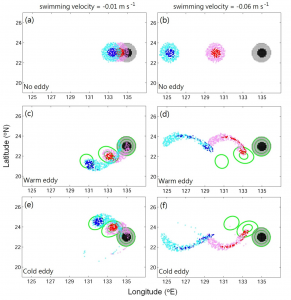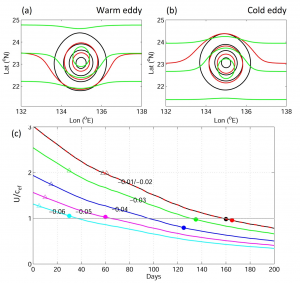by Yu-Lin Chang[1][2],
in collaboration with Yasumasa Miyazawa[3], Mélanie Béguer-Pon[4]
In this study[5], we explore the dynamical role of mesoscale eddies on fish larvae migration using the example of Subtropical Counter Current eddies and the migration of Japanese eel larvae in the western North Pacific Ocean. An idealized experiment is conducted to isolate the effects of eddies, and use a three-dimensional particle-tracking method to simulate virtual eel larvae (v-larvae) migration, including both horizontal and vertical swimming behaviors (Fig. 1).

The impact of eddies strongly depends on the swimming speed of v-larvae relative to the eddy speed. Eddies accelerate the movement of v-larvae that swim slower than the propagation speed of the eddy, whereas faster-swimming v-larvae are dragged by eddies (Fig. 2).

A modified stream function that incorporates biological swimming ability explains the non-uniform trapping of v-larvae in mesoscale eddies. A high swimming speed and/or a small eddy rotation speed results in a weak trapping capacity (Fig. 3). Simulations of v-larvae migration in realistic cases of eddy fields indicate that the abundance of eddies significantly affects the duration of larval migration, with the effects being largely dependent on the larvae swimming speed. We noted a negative relationship between the observed annual eel recruitment index in Taiwan and the eddy index subtropical countercurrent (STCC) region, which suggests a potentially important role of mesoscale eddies in eel larvae migration.

- [1] Institute of Marine Environmental Sciences and Technology, National Taiwan Normal University↩
- [2] Update Aug 1, 2017: Dr. Chang Joined JAMSTEC from Aug 1, 2017. ↩
- [3] Application Laboratory, Japan Agency for Marine-Earth Science and Technology↩
- [4] Department of Oceanography, Dalhousie University↩
- [5] Chang YL, Miyazawa Y, Beguer-Pon M (2017) The dynamical impact of mesoscale eddies on migration of Japanese eel larvae PLoS One 12:e0172501 doi:10.1371/journal.pone.0172501↩
